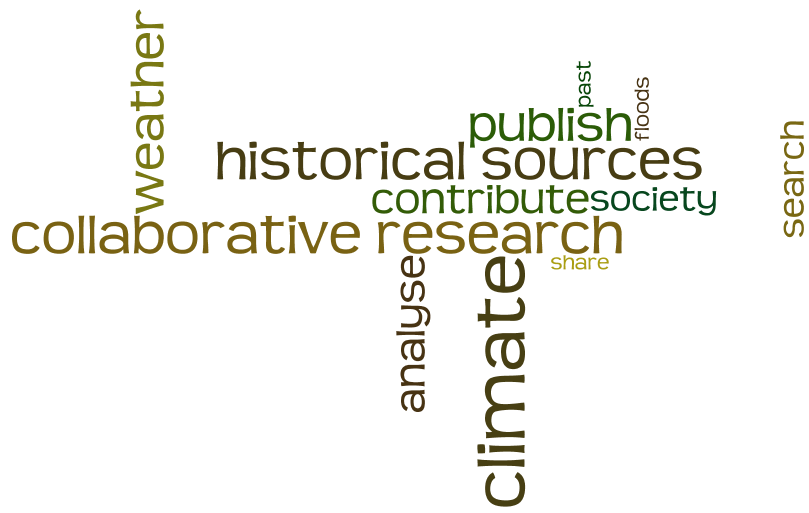Climate History Databases
Is there a database you'd like us to add? Contact Dr. Sam White with your suggestions.
The National Oceanic and Atmospheric Agency provides extensive databases of climate data obtained through proxies. For medieval and early modern historians the tree-ring (dendro) data is probably the most useful. The site also provides links to published climate data based on historical records. You can also search for data through the Paleoclimatology Data Map.
The Old World Drought Atlas, North American Drought Atlas, and Monsoon Asia Drought Atlas offer annual gridded reconstructions of dry/wet conditions based on networks of tree rings.
Tambora provides a database-supported infrastructure enabling the collaborative work on the interpretation of climate information derived from historical sources. The key information to be stored within the system is the original text quotation together with a bibliographic reference, place, time and coded information on climate and environment derived from the quote. The database has taken over information formerly in HISKILD (on early modern Germany) and is currently expanding.
The Japan Climate Data Project is building a database of documentary and early instrumental data on the weather and climate history of Japan and neighboring lands. The website also contains a full description of the current project, links, and publications based on its growing collections. Available in both in English and Japanese.
The National Center for Atmospheric Research (NCAR) has launched a tool for searching and evaluating climate data sets. NCAR explains the Climate Data Guide as “the go-to source for scientifically sound information and advice on the strengths, limitations, and applications of climate data. Experts who construct, evaluate, and compare climate data sets contribute their perspectives and advice on climate data and analysis methods for a broad community of data users. Users may participate by posting comments, questions, and links.” For now, there are only a few datasets going back more than a century, so it has limited use for historians. However, the searchability and clear evaluations of data make it a valuable tool for non-specialists.
The three-year research project Climates of Migration is a common project of The Rachel Carson Center for Environment and Society and the Institute for Advanced Study in the Humanities in Essen (KWI), funded by the German federal Ministry of Education and Research. The project looks at the historical intersections between environmental change and migration and is particularly interested in climate-induced movements of people in the past.
The Deutscher Wetterdienst operates Germany’s densest meteorological and climatological observing network. It has archived German weather observations that date back to the 18th century. In total, some 100 billion climate data entries have been gathered, processed, and archived.
The freely downloadable Climatological Database for the World's Oceans (CLIWOC) database represents the culmination of a project funded by the European Union and consists of 287,114 ship logs from the Dutch, English, French and Spanish navies. The vast majority of ship logs date from between 1750 and 1850, yet four ship logbooks were incorporated that predate 1750. Like papyrus scrolls for scholars of classical Egypt, ship logbooks, abounding with reliable meteorological information, form a vast and largely untouched documentary reservoir for historical climatologists.
Climate History Australia is a landmark initiative to reconstruct Australian climate over past centuries. Using a range of historical records, it pieces together past climate variability and extremes to understand their influence on Australian society over time. Understanding the past helps scientists estimate Australia’s vulnerability to continued climate change.
The international Atmospheric Circulation Reconstructions over the Earth (ACRE) initiative both undertakes and facilitates the recovery of historical instrumental surface terrestrial and marine global weather observations to underpin 4D weather reconstructions (reanalyses) spanning the last 200-250 years for climate applications and impacts needs worldwide.
The website of the University of East Anglia Climatic Research Unit Includes links to paleoclimate and instrumental data used in climate reconstructions, as well as information about the center and its academic programs.
The Smithsonian's "Volcanoes of the World" database describes the physical characteristics of Holocene volcanoes and their eruptions. This search returns a list which may be filtered based on a volcano name, volcano type, features, evidence of recent activity, location (set using a map), country, rock types, population within various distance ranges, or the availability of images. Name and country searches will also return subfeature names and synonyms; using other filters will result in only primary volcano names being returned. A standard set of fields is shown on the screen display, but full results with additional content may be downloaded into an Excel spreadsheet.
Since the 1980s, Euro-Climhist has set itself the task of collecting historical climate data left behind by humans, scrutinising the sources and then making it available free of charge to both scientists and the wider public with the aid of an independently developed system. Initially, the core was primarily data on Switzerland, but in recent years more and more data on Europe as a whole and on individual European regions has been added, currently ranging from the High Middle Ages to the present day.
The Reconstructed East Asian Climate Historical Encoded Series (REACHES) database is an ongoing project to digitize and standardize textual records of climate, and climate-related environmental changes, in Chinese history, from the second-century BCE until the modern era.














